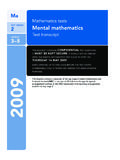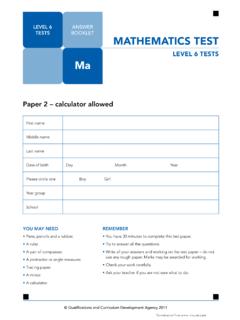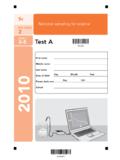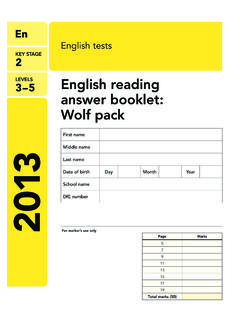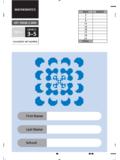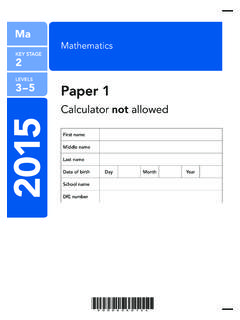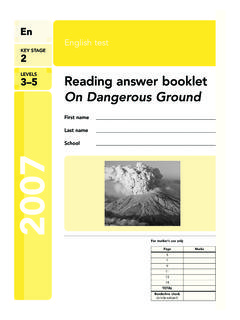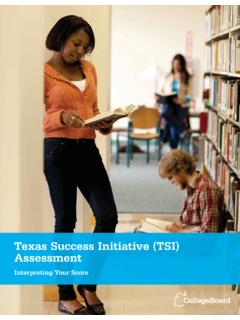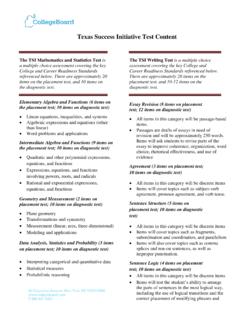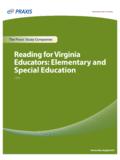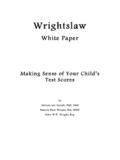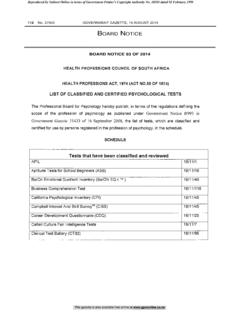Transcription of Reading test, Writing test and Spelling test 2003
1 20032 KEY STAGELEVELSEnKEY STAGEKEY STAGEKEY STAGEKEY STAGE2003 English testsMark schemesReading test, Writing test and Spelling test3 5 ContentsIntroduction3 The Reading test4 The Writing test28 The Spelling test533 IntroductionAs in previous years, external marking agencies, under contract to QCA, will mark the test markers will follow the mark schemes in this booklet, which are provided here to booklet includes the mark schemes for the assessment of Reading , Writing and Spelling . Forease of reference, the test questions have been reproduced in the mark schemes. Level thresholdtables will be posted on the QCA website, , on Monday 23 mark schemes were devised after trialling the tests with children and contain examples ofsome frequently recurring correct answers given in the trials. The mark schemes indicate thecriteria on which judgements should be made. In areas of uncertainty, however, markers shouldexercise professional judgement. From 2003 onwards, the same sets of assessment focuses for Reading and Writing are being usedfor the English tasks and tests at all key stages.
2 These provide fuller information about theparticular processes or skills the child needs in order to answer the questions. The focuses willenable teachers to gain clearer diagnostic information from their children s performance. Thereading assessment focuses are drawn from the national curriculum and are directly related to theNational Literacy Strategy s Framework for information is provided in order to explain the structure of each mark scheme as well as theway in which it will be used by external 2003 key stage 2 English tests and mark schemes were produced by the key stage 2 Englishteam at the National Foundation for Educational Research (NFER) on behalf of Reading testThe range of marks available for each question is given under the mark box in themargin of theReading Answer or unacceptable answers are given a mark of 0. No half marks are are several different answer formats: short answersThese may only be a word or phrase, and 1 markmay be awarded for each correctresponse.
3 Several line answersThese may be phrases or a sentence or two, and up to 2 marksmay be awarded. longer answersThese require a more detailed explanation of the child s opinion, and up to 3 marksmaybe awarded. other answersSome responses do not involve Writing and the requirements are explained in the mark scheme was devised after trialling the tests with children and contains examples ofsome frequently occurring correct answers given in the trials. These are shown in italics. Manychildren will, however, have different ways of wording an acceptable answer. In assessing eachanswer, markers must focus on the content of what has been written and not on the quality of thewriting, expression, grammatical construction, aspects of Reading to be assessed are children s ability to:1. use a range of strategies, including accurate decoding of text, to read for meaning;2. understand, describe, select or retrieve information, events or ideas from texts and usequotation and reference to text;3.
4 Deduce, infer or interpret information, events or ideas from texts;4. identify and comment on the structure and organisation of texts, including grammaticaland presentational features at text level;5. explain and comment on the writers use of language, including grammatical and literaryfeatures at word and sentence level;6. identify and comment on writers purposes and viewpoints, and the overall effect of thetext on the reader;7. relate texts to their social, cultural and historical contexts and literary following table identifies the questions (with marks available) that address each assessment focus:FocusAF2AF3AF4AF5AF6AF7 Section 1Q11Q21Q31Q41Q51Q6a1Q6b1Q72Q82Q9a1Q9b1Q1 03 Section 2Q111Q12a1Q12b1Q131Q142Q152Q163 Section 3Q171Q182Q192Q20a1Q20b1Q21a1Q21b1 Section 4Q221Q231Q241Q253Q262Q271 Section 5Q281Q293Q301 Total marks9273614 Assessment focus 1 underlies the Reading of and response to the text and questions in the testand is not explicitly separately assessed at key stage 2.
5 Not all focuses will be appropriate to,or appear in, any one test at any given level. 6 This page may be used for your own notes7 Section 1: Quiet HeroinePage tothe to the to a first person to notice the bear told the rest of the family to climbAssessment focus 2:understand, describe, select or retrieve information, events or ideas from texts and use quotation and reference to around in a upsetwith , everyoneAssessment focus 2:understand, describe, select or retrieve information, events or ideas from texts and use quotation and reference to bear was startled by a sudden noise and reared up,but they were all safely out of its reach because the ladder had Assessment focus 2:understand, describe, select or retrieve information, events or ideas from texts and use quotation and reference to out in and the little sisters were and CharlesAssessment focus 3:deduce, infer or interpret information, events or ideas from texts (simple inference).Assessment focus 3:deduce, infer or interpret information, events or ideas from texts (simple inference).
6 Fallen into the bear on the 1 5 Award1 markfor each correct page 6, in paragraphs 2 and 3, Lyddie had her backto the ) Why?1 markAssessment focus 3:deduce, infer or interpret information, events or ideas from texts (simple inference).Award1 markfor reference to Lyddie s attempt to control the situation / hold the bear s attention, eg: she s keeping her eye on the bear / watching the bear; she has to maintain her control over the bear; to try to distract the bear from looking at the others; to avoid alarming the not accept: so the bear could not see the others / she was protecting ) How did she know when the others had reached safety?1 markAssessment focus 3:deduce, infer or interpret information, events or ideas from texts (simple inference).Award1 markfor reference to (cessation of) sound, eg: the ladder stopped creaking / became silent; she could hear them moving up in the loft / hay is the ladder important in the story?Give to 2 marksAssessment focus 3:deduce, infer or interpret information, events or ideas from texts (simple inference).
7 Award1 mark for citing appropriate evidence of the ladder s crucial role in the story, up to a maximum of2: means of escape / to get to the loft / to get to safety; diverted the bear s attention / it hit the bear on the nose / confused the bear; they moved it before the bear got up it; Lyddie knew the others were safe when it stopped not accept: so that they could climb up it (without reference to escape or loft); so the bear could not get racket released the bear from the charm .. (top line, page 7).How was the atmosphere in the home different beforeandafterthis moment?up to 2 marksAssessment focus 3:deduce, infer or interpret information, events or ideas from texts (complex inference).Award2 marksfor accurate description of the atmosphere both before andafter the turning markfor accurate description of the atmosphere before orafter the turning must refer to the correct moment in the text to be tense quietness / terrified silence / shockafter panic / chaos / uproar / screamingFor example: in the house the atmosphere was calm before the ladder hit the bear but then the bear wentmad;(2 marks) before it was quiet, but it wasn t after.
8 (1 mark)Page 5 (continued) and his mother reacted to the danger differently from their focus 3:deduce, infer or interpret information, events or ideas from texts (complex inference).Charles 1 markAward1 markfor reference to his calm or active participation, eg: tried to help; got involved in the rescue; comforted the not accept: brave (without supporting evidence); markAward1 markfor reference to her terror or passivity, eg: frightened / scared / in a panic; followed the others / did as she was told; too frightened to take charge; just what ways did Lyddie show herself to be a good leader?Explain fully, using the text to help to 3 marksAssessment focus 3:deduce, infer or interpret information, events or ideas from texts (complex inference).Main points: protects / saves others; puts self at risk / brave; (quietly) authoritative / others listen to her / trust her; quick-thinking / alert; practical / controls the situation; calm / reassures marksfor a well-developed response referring to at least two aspects of her leadershipqualities, eg: even though Lyddie was just a child she did not panic and she knew what to do to control thebear, she got the rest of the family out of harm s way and only thought about saving herselfwhen she knew the others were marksfor a developed explanation of one of the above or brief reference to two or threemain points, eg: she put herself last by making sure her family was up in the loft, safe out of the bear s way,before she thought about herself.
9 She was the one who noticed the danger and she was the one who had a markfor reference to any one of the above or direct quotation of relevant section(s) of text,eg: she saved her family from the 6 (continued)12 Section 2: are the main places you can see superheroes now?Tick markAssessment focus 2:understand, describe, select or retrieve information, events or ideas from texts and use quotation and reference to mark for three correctly ticked televisionin filmsin museumsat the theatrein graphic novelsPage page 8, the writer has given reasons why some people like superhero adventures and others do down one reason why people like them and another reason why they do focus 2:understand, describe, select or retrieve information, events or ideas from texts and use quotation and reference to markfor each acceptable point from those listed below:Like1 mark exciting, full of suspense; escape from reality; interesting details / differences, eg: costumes / mark far-fetched / unrealistic; harmful influence on children.
10 Features of a superhero are described on page lines to show which one would be most useful in each of the following has been done for to 2 marksAssessment focus 2:understand, describe, select or retrieve information, events or ideas from texts and use quotation and reference to marks for all pairscorrectly markfortwoorthreecorrectly matched challengeWhat the superhero .. do these words on page 8 tell you about superheroes?1 markAssessment focus 5:explain and comment on the writers use of language, including grammatical and literary features at word and sentence markfor responses showing understanding of unique and/or individual, eg: they are special; they are all different; one of a not accept: individualoruniqueas the explanation; direct quotation from text without 8skills to take on any evilsuperhuman strengthpreventing an alien invasionlifting a carsolving a murder mystery protecting someone from a bullypassing unnoticed in a busy street a secret identitya sense of justicea sharp people sometimes perform heroic threeof the eight superhero features on page 9 could an ordinary person have?
